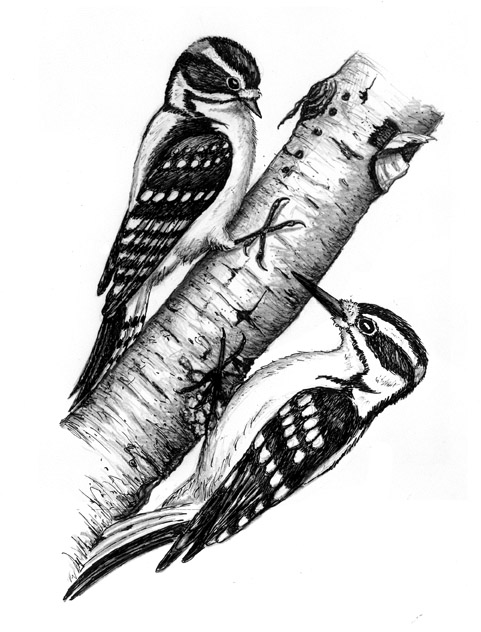
Dear Bird Folks,
I’m a new bird watcher who is particularly interested in woodpeckers. Right now my biggest challenge is trying to identify a Downy Woodpecker from a Hairy Woodpecker. I’m not sure which one we have in our yard. Could we have both?
– Ethan, fifth grade, Lakeville, MA
No problem, Ethan,
When I first received your note I was simply going to send you a copy of a column that I had recently written on this very topic. But then I discovered my idea of “recently” was a bit off. After checking my files, it turned out that I actually wrote that particular column in 2002, sixteen years ago. Oops. That’s before you were born and back when I was in the fifth grade…or not. Since you weren’t even alive when I first wrote about Downy and Hairy Woodpeckers, I’ve decided to write you a fresh column. Now I have a question for you. Are the kids in fifth grade still wearing paisley shirts? I’m sure they are, because that’s one fashion that will never go out of style…at least it hasn’t for me.
Anyone who likes woodpeckers is living in the right time period. Conversely, if you aren’t a woodpecker fan, you might want to travel back to the Colonial era. A few centuries ago, trees, and therefore woodpeckers, were in short supply. Early settlers had cut down all the forests for lumber or to create farmland. Without trees, woodpeckers had nothing to peck on. They were eventually forced to leave the Bay State for greener pastures. (BTW, Ethan, “greener pastures” is just an expression old people use. In reality, woodpeckers don’t much care for pastures, green or otherwise.) In more recent times, farming and lumbering have become less important to the local economy. This has resulted in the re-growth of the forests and the return of woodpeckers. This is probably more info about our woodpecker history than you wanted to know, but when you write your eventual doctorial thesis on this very topic, you’ll thank me.
Of our state’s seven species of resident woodpeckers, five species (Red-Headed, Red-bellied, Pileated, Northern Flicker and Yellow-bellied Sapsucker) look nothing alike and could easily be picked out of a lineup. But for some reason, there was a total lack of imagination when the Hairy and Downy were invented. These two different species are dressed in nearly identical outfits. (You would think at least one of them would have gone for the paisley look.) No worries, though. Sorting out which bird is which is totally doable, with just a few hints…and a bit of practice.
The key to identifying the Downy Woodpecker is the size. The bird is small. Even its name, “downy,” sounds small, like a kid’s squeaky toy. Only about the size of a Tufted Titmouse, the Downy Woodpecker is, in fact, the smallest woodpecker in all of North America. By contrast, the Hairy Woodpecker is nearly as large as a robin. And instead of a kid’s toy, think of something big and “hairy.” (Bigfoot might work, but the birds aren’t quite that large.) When the two woodpeckers are in close proximity, the size difference is quite obvious. When they are apart, however, identification is more challenging. But don’t worry; I have more clues, and none of them involve squeaky toys or Bigfoot.
Like the bird itself, a Downy Woodpecker’s beak is puny and not very woodpecker-like. It seems better designed for catching flies or nibbling on croissants. If you see a woodpecker, any woodpecker, with a menacing beak, it’s not a downy. By contrast, a hairy’s beak is large and has a serious dagger look to it. The overall impression is that this bird would not have any trouble hacking into a tree, or anything else.
The last clue has to do with behavior. While both birds have “woodpecker” in their name, it is the hairy that acts like one the most. It is typically seen foraging on tree trunks or thick branches. The downy can also be seen on tree trunks, but it will search for food on much thinner branches or on plant stems. They are often seen poking around in shrubs, kind of like songbirds. Speaking of songbirds: in the winter Downy Woodpeckers will associate with flocks of chickadees, titmice and nuthatches. And, if approached by a birder, a downy characteristically doesn’t fly off, but instead simply moves to the other side of the tree. Hairy Woodpeckers tend to be loners and don’t care to associate with other species and that includes us. (Who can blame them for that?) Some books point out that there are slight differences in head patterns and in the tail feathers of the two species, but I wouldn’t focus on those things. First of all, those differences are tricky to see in the field and secondly, they aren’t important. Just trust your own powers of observation. If the bird is the size of a robin, with a big, bad beak, it’s a hairy. If the bird is titmouse-size, with a puny beak, it’s our little pal, the Downy Woodpecker. It’s just that easy. (Well, you’ll need a bit of practice, too. Don’t forget about that.)
As to which species you have in your yard, Ethan, the answer is most likely both. While the downy is the more common of the two, the population of both birds has increased in recent years. Just keep in mind that if the beak is small, it’s a Downy Woodpecker and if the beak is dagger-like, it’s a hairy. If, however, you see something dressed in paisley, it’s probably me.